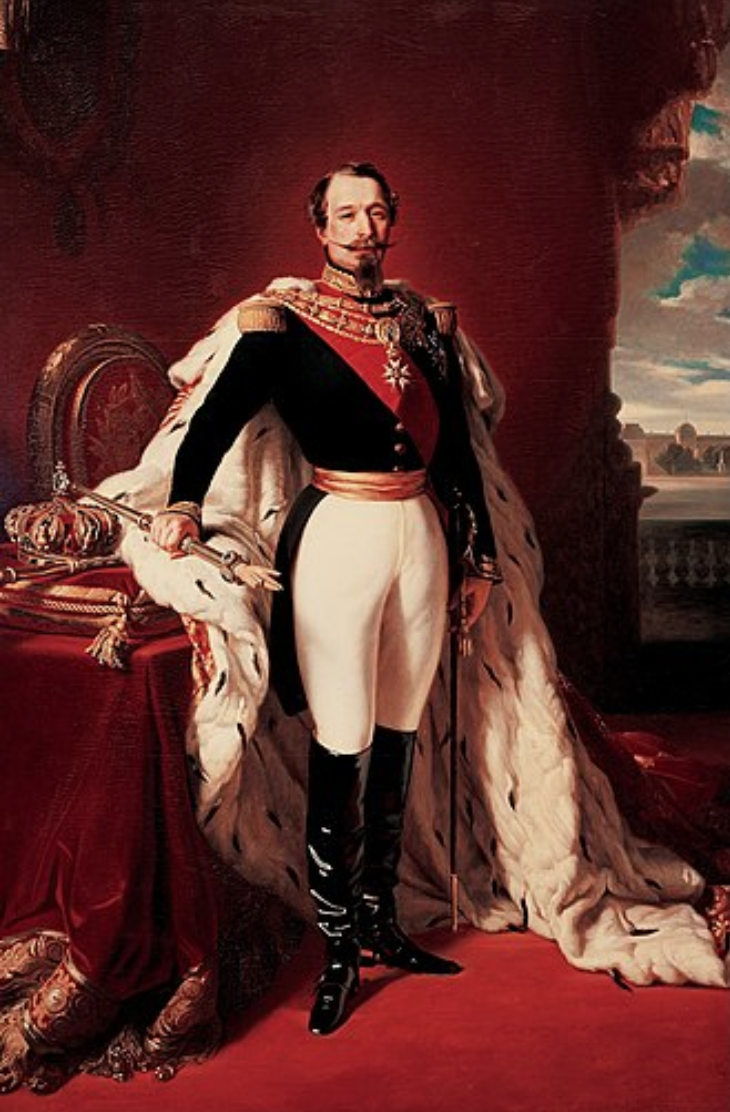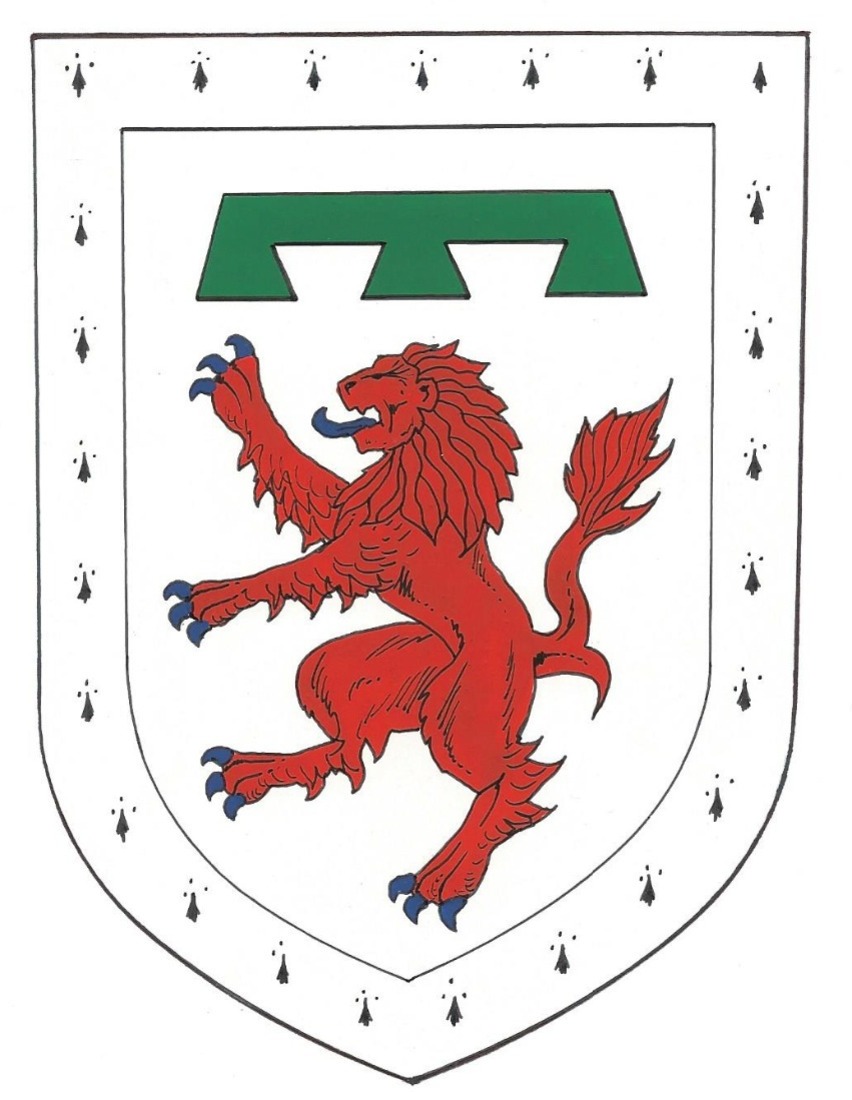Louis Napoleon III
Sovereign of the Order 1862-1875


Charles Louis Napoleon Bonaparte to give him his full title, was born in Paris in 1808 the third son (the first son having died in 1807) of Napoleon Bonaparte, his brother Louis Bonaparte King of Holland and Hortense de Beauharnois stepdaughter of Napoleon I, her mother being Napoleons first wife the Empress Josephine. His godfather was Napoleon Bonaparte and his godmother the Empress Marie Louise. His mother and father had a difficult relationship and only lived together for brief periods and although Louis was conceived during one of the rare periods, they were together, his father did not attend his baptism.
After Napoleons defeat at the Battle of Waterloo in 1815 and the Bourbon Restoration of the Monarchy, the Bonaparte’s were exiled from France and Louis’s elder brother went to live with their father in Italy while Louis stayed with his mother moving to Aix, Berne and Baden before finishing up at the castle of Arenenberg in 1817 which had been bought by his mother. After attending a grammar school in Augsburg Bavaria his education was continued with the assistance of private tutors one of whom was a close friend of Robespierre the architect of the French Revolutions Reign of Terror.
At the age of fifteen Louis and his mother moved to the Bonaparte Villa in Rome where he became reunited withhis elder brother. In 1830 he and his brother joined the Carbonari (charcoal burners),a revolutionist group fighting Papal and Austrian control of northern Italy and took part in an unsuccessful plot in Rome; the following year they became involved in the rebellion in central Italy during which his brother died (after contracting measles). This, followed by the death of Napoleon 1`s son the Duke of Reichstadt at Livorno, resulted in Louis becoming the head of the Bonaparte dynasty and thereby the pretender to the Imperial throne.
In 1832 determined to succeed to the French throne he began his quest by writing various political and military tracts and for the next two years lived in London with his uncle Joseph Bonaparte and although enjoying the social life of that city he also spent much time visiting factories in Birmingham and carried out considerable research on the economy of Britain. In 1834 he joined the Swiss militia becoming a captain of artillery and in 1836 following his support of a failed coup d`etat at Strasbourg against the French King Louis Phillipe he fled back to Switzerland. Despite the French threatening to invade unless Louis was returned to them the Swiss refused to hand him over but hostilities were avoided by Louis going voluntarily to America via London and Brazil. He returned to Arenenberg in 1837 via England under the name of Robinson in time to be with his mother at her death. However, because she was buried in her homeland of France, he was unable to attend the funeral and consequently moved once again to England where he met with such luminaries as Benjamin Disraeli, Michael Faraday and Charles Dickens.
It was during this sojourn in Britain that he not only attended but participated as you have already read in the famous Eglinton Tournament of 1839 organised by the then Sovereign Grand Commander of our Order Archibald Montgomery 13th Earl of Eglinton and Winton. This experience probably had a lasting effect on him as when he became Emperor of France, he arranged for the construction of the mock medieval castle of Pierrefonds close to Compiegne. In 1840 whilst still living in London he was arrested in Wimbledon shortly before a dual with Count Leon the illegitimate son of Napoleon Bonaparte. It is interesting to note that at that time he lived at no 17 Carlton House Terrace before moving around the corner to no 1 Carlton Gardens, these days the official residence of the British Foreign Secretary. (No 4 Carlton Gardens became General De Gaulle headquarters of the Free French Forces during World War II). A further unsuccessful attempt at a coup in Bolougne in 1840 saw him again arrested and sentenced to permanent confinement in the castle of Ham from which he eventually escaped again to London in 1846 disguised as a mason named Badinguet who had exchanged clothes with him and as a result Badinguet became his nickname when he later returned to France and his partisans were known as the Badingueux. A month after his escape his father died.
On learning of the Revolution in France in 1848, brought about through political corruption, industrial and agrarian depression, and the subsequent abdication of Louis Phillipe who had escaped to England under the pseudonym of Mr. Smith, Louis Napoleon travelled back to Paris and on being nominated by members of the Bonapartist party in that city as their candidate for the New Assembly, he was elected in four departments. Not satisfied and looking for much higher office, he declined to take his seat. Later that year as a result of his name, pedigree and the promise of bringing back national glory to France he was elected as President of the National Assembly for a period of four years but as the constitution forbade a second term as President he arranged another coup and in November 1852 was declared Emperor of France taking the throne on the 2nd of December of that same year, the 48th anniversary of Napoleon Bonaparte’s coronation.
In 1853 he married the Countess Maria-Eugenie, daughter of the Spanish nobleman the Count of Teba who bore him a son the Prince Imperial Eugene Louis Jean Joseph Napoleon. Mainly educated in Paris the Countesses formal education was completed at a boarding school near Bristol. Interestingly her maternal grandfather was William Kirkpatrick of Closeburn, a Scotsman who became the United States consul to Malaga and later a wine merchant. Throughout his life Louis had at least nine mistresses among who were Mathilde Bonaparte his cousin, Marie Anna Schless mother of his illegitimate son Bonaventure Karrer, Alexandrina Vergeot, laundress at the prison of Ham and mother of his sons Alexander and Louis Ernest as well as Elisa Rachel Felix the most famous actress in Europe at the time.
In April1855 Louis was invested in Windsor Castle with the insignia of the Most Noble Order of the Garter by Queen Victoria assisted by Prince Albert and the Duke of Cambridge. His Knight of the Garter plate is still on display in St George’s Chapel Windsor and his son’s cenotaph is in the nave. In January 1858 an unsuccessful attempt was made on his life by the anarchist Orsini.
Throughout his reign, known as the Second Republic, Louis Napoleon sought to do all he could to engender the modernisation, prosperity and greatness of France. He actively encouraged economic expansion including the establishment of institutions of credit, the modernisation of the French banking system and other means of furthering industry and agriculture which ended famine in France. He made the French merchant marine the second largest in the world and promoted technical and public works including the construction of the rail network, supported inventors as well as involving himself in the modernisation of Paris by replacing its unhygienic medieval streets with wide boulevards, creating a sewerage system, building parks and sanitary housing in apartment blocks for the workers, arranging for similar works to be carried out in Marseille, Lyon and other French cities. Social reforms included giving French workers the right to strike and establishing boards of arbitration as well as introducing a new economic policy based on free trade principles, he also agreed a commercial treaty with Great Britain and other European countries.
He was also instrumental in expanding the right to organise women’s education and involved himself in the restoration of numerous medieval buildings which had fallen into disuse following the French revolutions. He also gave a prize to anyone who could invent an inexpensive substitute for butter and so margarine developed. Nowadays he is regarded as having enabled France to modernise itself and is recognised as the first ruler of France to have taken great care of the economy.
Activity on the military front saw him increase French presence in Indochina and West Africa and in 1859 leading his troops in Italy oversaw French victories at Montebella, Magenta, Lombardy and Solferino which led to the unification of Italy for which he received on behalf of France, Savoy and Nice. In 1860 he became involved with the British in declaring war on China and following victories in Palikao and Peking a treaty was agreed in which Chinese ports were opened up to western trade, European Ambassadors and Diplomats. He proposed the construction of the Suez Canal in conjunction with Britain and together they formed an alliance to check Russian aggression towards Turkey which resulted in the Crimean War. In 1861 he sent an expeditionary force to Mexico and in 1863 established Arch Duke Maximillian Frederick Joseph Habsburg, brother of the Emperor of Austria as Emperor of Mexico, although this did not turn out to be a successful enterprise, the French having to leave Mexico after intervention by the USA following which Maximillian.was deposed and executed.
1862 was the year Charles Louis Napoleon III became Sovereign of the Order of the Fleur de Lys (N.B. ruling monarchs are known as Sovereign’s of the Order all others being known as Sovereign Grand Commanders to show they act on behalf of the Sovereign who is considered to be unknown at that point).Disputes with Prussia led to the Franco Prussian war in 1870 and his defeat by Bismarck at the Battle of Sedan, saw him captured, incarcerated at Wilhelmshohe Palace in Kassel which led to him being deposed as Emperor of France which in turn resulted in the decline of the Second Republic which was quickly replaced by the Third Republic. He was released by the Prussians in 1871 and again went into exile in England where his wife and son awaited him.
Living out the remainder of his life at Camden Place in Chislehurst Kent he died in 1873 after undergoing an operation for the removal of bladder stones and was buried initially at St Mary’s Church Chislehurst. His son the Imperial Prince Eugene Louis who had attended Kings College London and then the Royal Military Academy at Woolwich was killed while serving with the British Royal Engineers fighting against the Zulu’s in 1879 following which Empress Eugenie arranged for the Benedictine St Michael’s Abbey Farnborough Hampshire to be built incorporating a mausoleum where both her husband and sons remains were placed. Following her death in Madrid in 1920 she was also laid to rest in the mausoleum.
Despite having been ignored by the country of his birth for over a century, in 2007 Christian Estrosi, a French Minister of State arrived at St Michaels Abbey in Hampshire to request that the remains of Louis Napoleon be returned to France by the year 2010 for the one hundred and fifty years anniversary of Nice becoming part of France through Napoleon III. In denying this request the Abbot of St Michael’s later reported “the French Minister left with a fuller appreciation of what’s here and why it should continue to be.
There are some curious numerical coincidences associated with Napoleon III and Eugenie. The last complete year of their reign was 1869 (Napoleon being dethroned and exiled in 1870). If to the year of the Emperors coronation (1852) that of the year of birth of Napoleon or Eugenie is added or the date of marriage the sum will always be 1869. i.e. adding Napoleons birth year 1+8+0+8 to 1852 = 1869; using Eugenie’s birth year 1+8+2+6 +1852 = 1869 and with the year of marriage we also get 1+8+5+3 +1852 =1869.

























